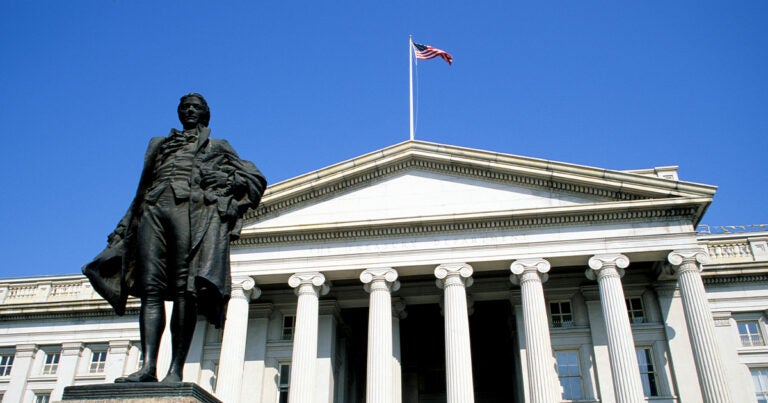Four times per year, the U.S. Treasury Department conducts what is known as the Quarterly Refunding process. This undertaking occurs about one month into a new quarter, and is a formal, multi-day consultation between an advisory committee — the Treasury Borrowing Advisory Committee (TBAC) — comprised of financial market participants and officials from the Treasury Department. The goal is to communicate with financial market participants on the outlook for U.S. Treasury debt issuance and U.S. debt market conditions.
As part of this process, the U.S. Department of the Treasury releases several publications containing information on historical and future borrowing activities. Those publications offer valuable insights into the nation’s fiscal situation, including how much the government expects to borrow, the composition of Treasury debt, and factors influencing the Treasury’s decision-making.
Key highlights from the most recent Quarterly Refunding include an increase in anticipated borrowing of $158 billion compared to the same period in the previous year. As part of the quarterly refunding process, Treasury officials and members of the TBAC consider the size and composition of prospective Treasury offerings. In recent years, shorter-term treasuries have become a larger part of the issuance strategy. As part of the most recent review, Treasury reaffirmed this approach to financing U.S. obligations. This strategy contrasts with Treasury’s approach to its portfolio in the prior decade, and offers relatively reduced costs, at the expense of greater exposure to volatility and interest-rate risk.
Quarterly Treasury Borrowing Estimates
According to the most recent guidance, the Treasury anticipates borrowing $1,147 billion over the next two quarters, covering the periods of October-December and January-March, which is the first half of fiscal year 2026. This would be $158 billion more debt than it issued during the same period last year. Treasury expects to borrow more compared to the previous period because, at that time, the government was operating under “extraordinary measures” after the national debt reached the debt ceiling. Those measures include drawing down on the Treasury’s General Account cash balance instead of borrowing to finance government activities. Now that the ceiling has been lifted to $41.1 trillion by the One Big Beautiful Bill Act, Treasury borrowing activity is expected to stabilize.
Looking back, the U.S. government has borrowed $2.1 trillion over the past 12 months. If the Treasury’s expectations about the next two quarters prove accurate, the U.S. government will have borrowed more than $500 billion in 10 of the last 13 quarters after doing so only six times in the prior two decades.
Short-Term Securities Have Been Slightly Higher as a Share of Treasury Borrowing Since the Middle of 2023
As borrowing has risen, the Treasury has generally been increasing the proportion of bills (maturity of one year or less) in its portfolio of marketable securities. That pattern reflects, in part, the response to economic disruptions necessitating rapid borrowing:
- From May 2015 through February 2020, bills as a share of outstanding debt generally hovered between 10 and 15 percent, with very few sudden fluctuations. In October 2015, bills as a percentage of Treasury’s outstanding securities were less than 10 percent, a multi-decade low.
- In February 2020, the pandemic drove unprecedented borrowing needs, and the proportion of bills jumped to 22 percent by April 2020. The total supply of bills doubled in one year, and the share remained above 20 percent until June 2021.
- From August 2021 to June 2023, the percentage of bills receded from the pandemic peak and sat between 15 and 18 percent.
- After the Fiscal Responsibility Act was enacted, which included a temporary suspension of the debt ceiling, the issuance of bills rose again to replenish Treasury’s cash reserves (which had been depleted during the debt limit impasse). The proportion of bills exceeded 20 percent in September 2023 and remains above that level today.
- In recent months, Treasury has relied on shorter-term bills (4-, 6-, and 8-week) to replenish its cash balance instead of cash management bills.
- Treasury intends to maintain its current portfolio composition, which is more indexed towards short-term issuances than in previous years.
Treasury Borrowing Insights
One of the documents released as part of the Quarterly Refunding process is a report compiled by the TBAC, which highlights significant changes in Treasury borrowing and outlines trends from the perspective of market participants. Some interesting areas to note:
- TBAC noted that the government shutdown may be contributing to low volatility in financial markets, as the release of economic data has been delayed.
- TBAC made note of two key economic indicators: job growth has slowed in comparison to other measures of economic activity, and inflation remains elevated.
- TBAC acknowledged that since 2019, the level and volatility of debt issuance have increased significantly due to growing deficits, debt growth, and elevated rates.
- TBAC had much discussion surrounding the costs of debt issuance versus the volatility invited by portfolio composition and concluded that the current strategy would persist. However, the uncertainty of potential financing needs leaves room for future adjustments.
Photo by Anna Moneymaker/Getty Images
Further Reading
What Types of Securities Does the Treasury Issue?
Let’s take a closer look at a few key characteristics of Treasury borrowing that can affect its budgetary cost.
Experts Identify Lessons from History for America Today
A distinguished group of experts to evaluate America’s current fiscal landscape with an historical perspective.
The Fed Reduced the Short-Term Rate Again, but Interest Costs Remain High
High interest rates on U.S. Treasury securities increase the federal government’s borrowing costs.


